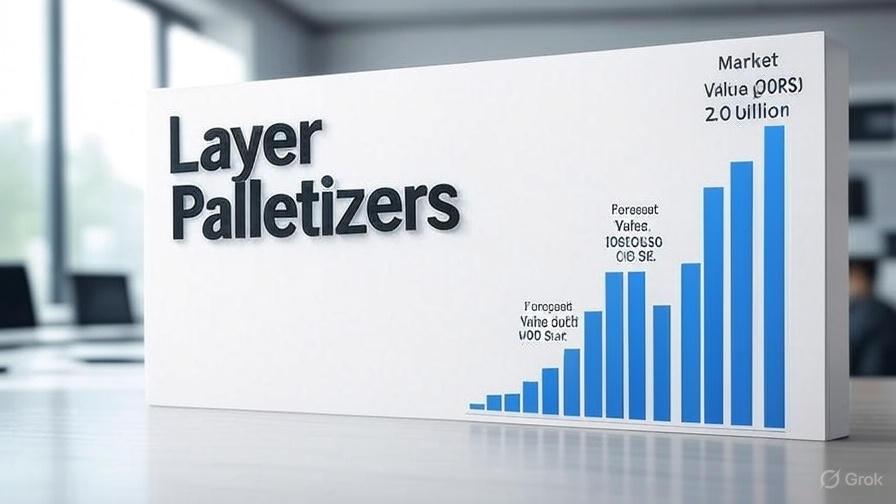Layer Palletizers Market to Hit USD 3.4 billion by 2035

The global layer palletizers market is entering a transformative decade, blending automation, robotics, and sustainable design into one of the most vital material handling segments. Valued at USD 2.0 billion in 2025 and projected to reach USD 3.4 billion by 2035 at a CAGR of 5.5%, the market reflects an industry that is not only scaling but also adapting to the rapid shifts in manufacturing, warehousing, and logistics worldwide. For established global leaders and emerging manufacturers alike, the opportunities to expand, innovate, and capture market share have never been greater.
Full Market Report available for delivery. For purchase or customization, please request here: https://www.futuremarketinsights.com/reports/sample/rep-gb-25268
Market Dynamics and Cost Structure
The economics of the layer palletizers market are closely tied to its core components and integration requirements. Hardware remains the largest cost driver, with conveyors, robotic arms, and pallet handling modules representing significant investments. Alongside hardware, advanced automation software adds another layer of value, enabling programmable flexibility and precision stacking. Labor, assembly, and long-term service commitments continue to shape operational expenditures, especially in regions where semi-automated systems still coexist with advanced robotics.
Within the value chain, upstream suppliers of motors, sensors, and control systems provide essential inputs that drive efficiency, while system integrators bring customization and installation expertise. OEMs dominate the midstream, while distributors and service providers form the critical downstream link, ensuring reliability and customer support. Modular designs and advanced controls are steadily improving cost competitiveness, helping manufacturers balance affordability with performance.
Market Position and Growth Potential
Layer palletizers occupy an important position across the wider automation ecosystem. They account for nearly 5.1% of the palletizing equipment industry, 3.8% of the broader packaging automation market, and 3.3% of warehouse automation systems. Their role is especially pronounced in food and beverage packaging machinery, where they secure a 4.2% share due to the high standards of speed, hygiene, and handling consistency demanded by the sector.
The continued rise of e-commerce, distribution hubs, and logistics networks further boosts demand, as companies seek efficient, reliable, and safe material handling solutions. This convergence of packaging, warehousing, and supply chain optimization places layer palletizers firmly at the heart of modern industrial operations.
Driving Forces Behind Growth
The adoption of layer palletizers is being fueled by a global push for automation in packaging and logistics. Companies are investing to reduce labor dependency, enhance workplace safety, and maintain consistent product handling. Robotics, AI-driven vision systems, and advanced control software are enabling machines to adapt to different product formats with higher speed and accuracy.
Operational safety, ergonomic designs, and space optimization have become defining considerations for companies, leading to stronger adoption of robotic palletizers over traditional manual stacking. Moreover, Industry 4.0 integration is accelerating growth, with real-time monitoring, predictive maintenance, and digital twin technology reshaping operational efficiency.
Segmental Insights
Among product types, robotic palletizers dominate with 49.5% of market revenue in 2025. Their ability to handle high-speed, multi-line operations with precision and flexibility is unmatched, making them the preferred choice for industries requiring adaptability and uptime.
In terms of capacity, the medium segment holds 47.3% of revenue, providing the right balance between throughput and investment costs. This category is particularly attractive to mid-to-large scale manufacturers that demand efficiency without the footprint of high-capacity systems.
For applications, boxes and cases lead with 44.6% of market share, reflecting the universal need for secure, stable, and efficient handling of packaged goods across industries.
Regional Outlook
China stands at the forefront of global growth with a forecast CAGR of 7.4%, supported by massive industrial automation and packaging demand. India follows closely at 6.9%, driven by booming FMCG, pharmaceutical exports, and the integration of smart factory technologies. Germany, with a CAGR of 6.3%, remains Europe’s powerhouse, leveraging engineering standards and Industry 4.0 adoption. The United States shows steady expansion at 4.7%, where palletizers are central to food, beverage, and e-commerce warehousing operations. Meanwhile, the UK, Brazil, and other emerging markets continue to drive regional opportunities through modernization and logistics optimization.
Competitive Landscape
The layer palletizers market is shaped by a mix of global giants and specialized innovators. KUKA AG, Honeywell International Inc, and Körber AG are setting benchmarks with robotic and AI-driven palletizers designed for speed and precision. Premier Tech and Scott Automation focus on flexible, modular systems for diverse industries. BW Flexible Systems, Concetti SpA, and Mollers Packaging Technology GmbH offer tailored solutions for cartons, bags, and bulk goods.
Emerging players like COSMAPACK, TMI, Segbert Palletizing and Automation, and PHS Innovate are making strides with cost-efficient, turnkey solutions that improve regional competitiveness. Companies such as Brolla and SMB are carving niches by addressing specific packaging and material handling needs. Across the board, sustainability, digitalization, and warehouse optimization are central to competitive strategies.
- Art
- Causes
- Crafts
- Dance
- Drinks
- Film
- Fitness
- Food
- Παιχνίδια
- Gardening
- Health
- Κεντρική Σελίδα
- Literature
- Music
- Networking
- άλλο
- Party
- Religion
- Shopping
- Sports
- Theater
- Wellness


